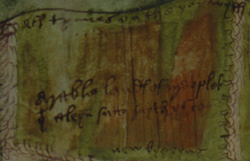 |
 |
 |
 |
 |
 |
 |
|
Woodland (12/15) High hills surround the valley,
encircling it like a crown. Walter Daniel’s lyrical description of Rievaulx in the twelfth century suggests that the abbey precinct was at this time surrounded by woodland. Woodland afforded shelter and privacy, but also provided valuable resources including charcoal for burning in the forges, as well as building materials such as timber and thatch. It could also be used as pasturage for animals, particularly pigs, which could graze on acorns and beech nuts here. In the late twelfth century, Bernard de Balliol gave the monks pasture rights in his forests at Teesdale and Westerdale. His grant included the right to keep sixty brood mares in the forest of Teesdale and also to make lodges and folds in both places. The abbey had also at this time grazing rights in the forest of Helmsley; thirteenth-century acquisitions included grazing rights in Swaledale. Charters and court cases shed considerable light on the resources afforded by forests and the activities that went on therein. A particularly interesting example is the dispute, 1231/2, between Abbot Roger of Rievaulx and the abbey’s patron, William Ros, regarding land in Griff and Tilleston, common pasture and wood in Hamelak and Pockele.(38) The argument centred on William’s assertion that he had a forest in the woods here; accordingly, he had his foresters keep wild beasts in the woods and lands belonging to the abbot, within the bounds of nine carucates. Abbot Roger argued that the presence of William’s foresters had hindered him from having common of herbage and mast or his cattle, in the woods of Hamelak and Pockele, as well as common of brushwood and timber; more importantly, William’s actions were contrary to the charter of his father, Robert of Ros.
This dispute resulted in lengthy legislative proceedings, but William eventually agreed to deforest these lands and not to demand by right a forest. William made a number of other concessions to the abbot, which provide further information about daily life in the forest, and how the woodland was utilised. William agreed that he should not take birds nesting or put keepers or foresters within the said nine carucates and assart, but that the abbot and his successors should have their own keepers and foresters to keep the woods and lands there; he conceded that the community could take wild beasts and all sorts of game with their dogs and greyhounds, and also their bows and arrows, unhindered by either him or his heirs. Furthermore, William granted the abbot common of herbage, mast, brushwood and timber in all the woods and holdings of Hamelak and Pockele except in the old park east of Hamelak and another to the west, called ‘le Haye’, and wood called Plocwude; whilst Rievaulx might not have any common there the community might take all the brushwood and timber it required and also for its beasts and flocks, except goats. The monks were also to have free way for their men, herds and carts. The abbot, in return, gave William 200m silver. The case between the abbot of Rievaulx and Gilbert de Gaunt in 1252, which was decided in the abbot’s favour, is equally incisive and provides an unusually vivid insight to the sights and sounds of the medieval forest. The terms of this agreement stipulated that in Gilbert’s forest of Swaledale, the abbot should have dogs, horns and all necessities for his house, hedges, hearths, folds and lodges and other easements which he ought and used to have (i.e. by custom – by right).(39)
|
